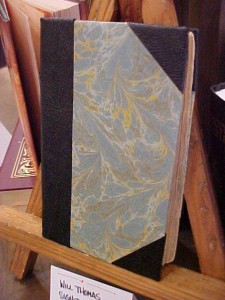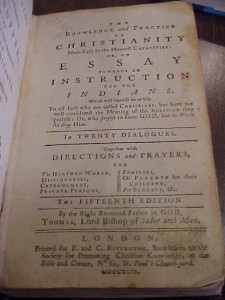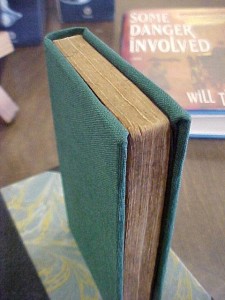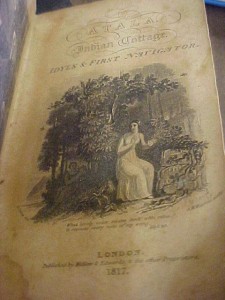Well! These books are back together! The book doctor is pleased to report the patients have come through surgery with no ill-effects.

Anyone who saw the shelves in the old store could easily see that I’m no carpenter. The inventory was displayed just fine, but the bookcases were nothing to look at, I’ll admit. Most of my life I’ve constructed things with words rather than my hands. Maybe that’s why I feel proud at finishing this sort of project.
There are a few nervous moments for me, repairing books like these. Both date almost to the colonial era. I’d hate for them to have survived so long just to have me ruin them. Of course, the other side of their age and survival is they both appeared to have been dragged behind covered wagons to end up in Broken Arrow.
At this point, I’ve had a little more experience doctorin’ books than building bookcases but still consider myself a mere “practical” bookbinder. The leather and marbled paper book in the picture is as close as I get to fine binding. Those folks doing the gilt inlays and embossed stamping are out of my league.

The book in the image with the black-colored spine was published in MDCCXCII – or 1792 for the non-Roman-numeral readers among us. (I looked it up to be certain…) You can click on any of the images for a bigger view of the type of printing that was produced two hundred years ago. Both have that antique flavor, being old enough to have been in the hands of our country’s founding fathers.
The larger of the two books was in such sad shape that it lacked the original materials covering the front and back.
I was able to re-use the boards, which were sort of odd shaped and round-cornered from years of handling. Even recovered they remain somewhat out-of-square, but I am pleased at the way the leather and marbled paper turned out.
The leather at the spine and corners was taken from a hide purchased from a fine-leather dealer in Tulsa. The marbled paper came from Israel, where an artisan makes each sheet individually. It’s an art form that has been saved, thankfully, but the sheets are somewhat pricey compared to stock paper.

When I was prepping the book, I could see the old twine cords that the original binder used to attach the front and back covers to the pages. His old linen stitching holding the book block together was pretty much intact. (A volume I’m working on currently had to be hand-sewn back together…)
The smaller book did not have a cover at all. I had to custom fit some boards to the pages and attached a cloth binding rather than leather and paper. It’s an early, early novella called Atala that was first published in 1801. The author, François-René de Chateaubriand, was inspired by his travels to North America. The little book is an 1817 translation that was published in London. Somehow, hand-sized volume found its way to what was Indian Territory and wilderness, back then.
Next time, I’ll try to remember to take a picture to show the state of the book when it comes in for the doctor’s visit. As for these two, I won’t profess them to be good as new, but with a little care they should hold up for another hundred years or so.




